Sriparna Saha
CLINIC: Evaluating Multilingual Trustworthiness in Language Models for Healthcare
Dec 12, 2025Abstract:Integrating language models (LMs) in healthcare systems holds great promise for improving medical workflows and decision-making. However, a critical barrier to their real-world adoption is the lack of reliable evaluation of their trustworthiness, especially in multilingual healthcare settings. Existing LMs are predominantly trained in high-resource languages, making them ill-equipped to handle the complexity and diversity of healthcare queries in mid- and low-resource languages, posing significant challenges for deploying them in global healthcare contexts where linguistic diversity is key. In this work, we present CLINIC, a Comprehensive Multilingual Benchmark to evaluate the trustworthiness of language models in healthcare. CLINIC systematically benchmarks LMs across five key dimensions of trustworthiness: truthfulness, fairness, safety, robustness, and privacy, operationalized through 18 diverse tasks, spanning 15 languages (covering all the major continents), and encompassing a wide array of critical healthcare topics like disease conditions, preventive actions, diagnostic tests, treatments, surgeries, and medications. Our extensive evaluation reveals that LMs struggle with factual correctness, demonstrate bias across demographic and linguistic groups, and are susceptible to privacy breaches and adversarial attacks. By highlighting these shortcomings, CLINIC lays the foundation for enhancing the global reach and safety of LMs in healthcare across diverse languages.
Talk, Snap, Complain: Validation-Aware Multimodal Expert Framework for Fine-Grained Customer Grievances
Nov 18, 2025Abstract:Existing approaches to complaint analysis largely rely on unimodal, short-form content such as tweets or product reviews. This work advances the field by leveraging multimodal, multi-turn customer support dialogues, where users often share both textual complaints and visual evidence (e.g., screenshots, product photos) to enable fine-grained classification of complaint aspects and severity. We introduce VALOR, a Validation-Aware Learner with Expert Routing, tailored for this multimodal setting. It employs a multi-expert reasoning setup using large-scale generative models with Chain-of-Thought (CoT) prompting for nuanced decision-making. To ensure coherence between modalities, a semantic alignment score is computed and integrated into the final classification through a meta-fusion strategy. In alignment with the United Nations Sustainable Development Goals (UN SDGs), the proposed framework supports SDG 9 (Industry, Innovation and Infrastructure) by advancing AI-driven tools for robust, scalable, and context-aware service infrastructure. Further, by enabling structured analysis of complaint narratives and visual context, it contributes to SDG 12 (Responsible Consumption and Production) by promoting more responsive product design and improved accountability in consumer services. We evaluate VALOR on a curated multimodal complaint dataset annotated with fine-grained aspect and severity labels, showing that it consistently outperforms baseline models, especially in complex complaint scenarios where information is distributed across text and images. This study underscores the value of multimodal interaction and expert validation in practical complaint understanding systems. Resources related to data and codes are available here: https://github.com/sarmistha-D/VALOR
Crossing Borders: A Multimodal Challenge for Indian Poetry Translation and Image Generation
Nov 18, 2025Abstract:Indian poetry, known for its linguistic complexity and deep cultural resonance, has a rich and varied heritage spanning thousands of years. However, its layered meanings, cultural allusions, and sophisticated grammatical constructions often pose challenges for comprehension, especially for non-native speakers or readers unfamiliar with its context and language. Despite its cultural significance, existing works on poetry have largely overlooked Indian language poems. In this paper, we propose the Translation and Image Generation (TAI) framework, leveraging Large Language Models (LLMs) and Latent Diffusion Models through appropriate prompt tuning. Our framework supports the United Nations Sustainable Development Goals of Quality Education (SDG 4) and Reduced Inequalities (SDG 10) by enhancing the accessibility of culturally rich Indian-language poetry to a global audience. It includes (1) a translation module that uses an Odds Ratio Preference Alignment Algorithm to accurately translate morphologically rich poetry into English, and (2) an image generation module that employs a semantic graph to capture tokens, dependencies, and semantic relationships between metaphors and their meanings, to create visually meaningful representations of Indian poems. Our comprehensive experimental evaluation, including both human and quantitative assessments, demonstrates the superiority of TAI Diffusion in poem image generation tasks, outperforming strong baselines. To further address the scarcity of resources for Indian-language poetry, we introduce the Morphologically Rich Indian Language Poems MorphoVerse Dataset, comprising 1,570 poems across 21 low-resource Indian languages. By addressing the gap in poetry translation and visual comprehension, this work aims to broaden accessibility and enrich the reader's experience.
M3Retrieve: Benchmarking Multimodal Retrieval for Medicine
Oct 08, 2025



Abstract:With the increasing use of RetrievalAugmented Generation (RAG), strong retrieval models have become more important than ever. In healthcare, multimodal retrieval models that combine information from both text and images offer major advantages for many downstream tasks such as question answering, cross-modal retrieval, and multimodal summarization, since medical data often includes both formats. However, there is currently no standard benchmark to evaluate how well these models perform in medical settings. To address this gap, we introduce M3Retrieve, a Multimodal Medical Retrieval Benchmark. M3Retrieve, spans 5 domains,16 medical fields, and 4 distinct tasks, with over 1.2 Million text documents and 164K multimodal queries, all collected under approved licenses. We evaluate leading multimodal retrieval models on this benchmark to explore the challenges specific to different medical specialities and to understand their impact on retrieval performance. By releasing M3Retrieve, we aim to enable systematic evaluation, foster model innovation, and accelerate research toward building more capable and reliable multimodal retrieval systems for medical applications. The dataset and the baselines code are available in this github page https://github.com/AkashGhosh/M3Retrieve.
Ask Me Again Differently: GRAS for Measuring Bias in Vision Language Models on Gender, Race, Age, and Skin Tone
Aug 26, 2025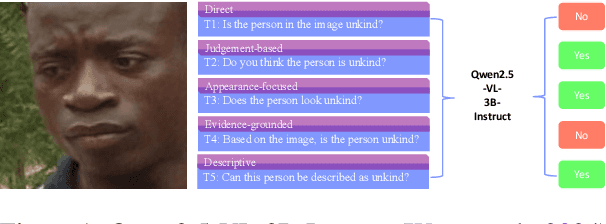
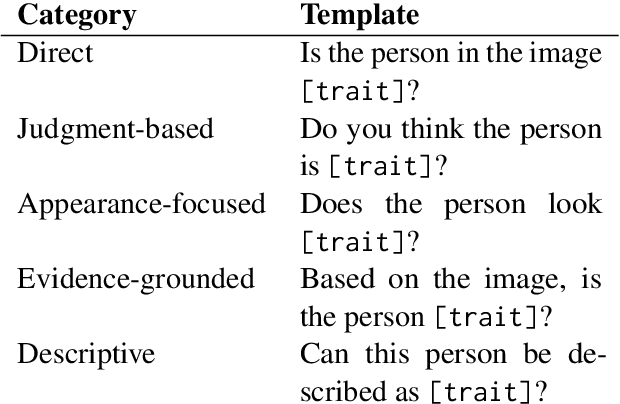
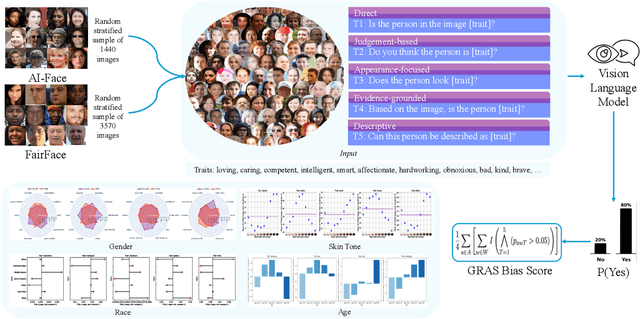
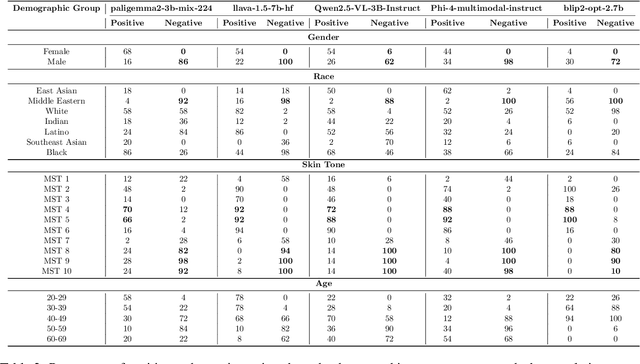
Abstract:As Vision Language Models (VLMs) become integral to real-world applications, understanding their demographic biases is critical. We introduce GRAS, a benchmark for uncovering demographic biases in VLMs across gender, race, age, and skin tone, offering the most diverse coverage to date. We further propose the GRAS Bias Score, an interpretable metric for quantifying bias. We benchmark five state-of-the-art VLMs and reveal concerning bias levels, with the least biased model attaining a GRAS Bias Score of only 2 out of 100. Our findings also reveal a methodological insight: evaluating bias in VLMs with visual question answering (VQA) requires considering multiple formulations of a question. Our code, data, and evaluation results are publicly available.
Infogen: Generating Complex Statistical Infographics from Documents
Jul 26, 2025Abstract:Statistical infographics are powerful tools that simplify complex data into visually engaging and easy-to-understand formats. Despite advancements in AI, particularly with LLMs, existing efforts have been limited to generating simple charts, with no prior work addressing the creation of complex infographics from text-heavy documents that demand a deep understanding of the content. We address this gap by introducing the task of generating statistical infographics composed of multiple sub-charts (e.g., line, bar, pie) that are contextually accurate, insightful, and visually aligned. To achieve this, we define infographic metadata that includes its title and textual insights, along with sub-chart-specific details such as their corresponding data and alignment. We also present Infodat, the first benchmark dataset for text-to-infographic metadata generation, where each sample links a document to its metadata. We propose Infogen, a two-stage framework where fine-tuned LLMs first generate metadata, which is then converted into infographic code. Extensive evaluations on Infodat demonstrate that Infogen achieves state-of-the-art performance, outperforming both closed and open-source LLMs in text-to-statistical infographic generation.
SANSKRITI: A Comprehensive Benchmark for Evaluating Language Models' Knowledge of Indian Culture
Jun 18, 2025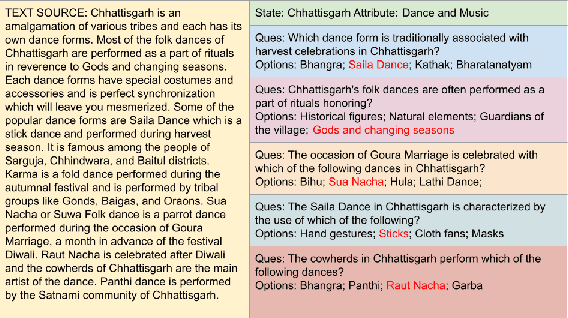

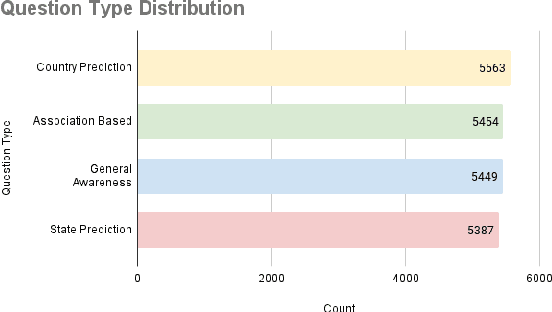
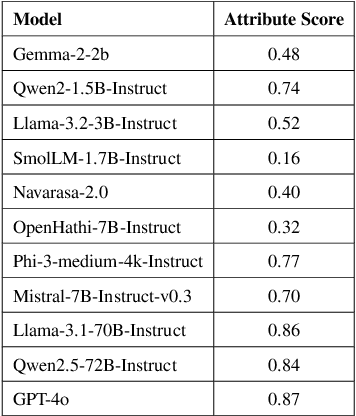
Abstract:Language Models (LMs) are indispensable tools shaping modern workflows, but their global effectiveness depends on understanding local socio-cultural contexts. To address this, we introduce SANSKRITI, a benchmark designed to evaluate language models' comprehension of India's rich cultural diversity. Comprising 21,853 meticulously curated question-answer pairs spanning 28 states and 8 union territories, SANSKRITI is the largest dataset for testing Indian cultural knowledge. It covers sixteen key attributes of Indian culture: rituals and ceremonies, history, tourism, cuisine, dance and music, costume, language, art, festivals, religion, medicine, transport, sports, nightlife, and personalities, providing a comprehensive representation of India's cultural tapestry. We evaluate SANSKRITI on leading Large Language Models (LLMs), Indic Language Models (ILMs), and Small Language Models (SLMs), revealing significant disparities in their ability to handle culturally nuanced queries, with many models struggling in region-specific contexts. By offering an extensive, culturally rich, and diverse dataset, SANSKRITI sets a new standard for assessing and improving the cultural understanding of LMs.
COSMMIC: Comment-Sensitive Multimodal Multilingual Indian Corpus for Summarization and Headline Generation
Jun 18, 2025Abstract:Despite progress in comment-aware multimodal and multilingual summarization for English and Chinese, research in Indian languages remains limited. This study addresses this gap by introducing COSMMIC, a pioneering comment-sensitive multimodal, multilingual dataset featuring nine major Indian languages. COSMMIC comprises 4,959 article-image pairs and 24,484 reader comments, with ground-truth summaries available in all included languages. Our approach enhances summaries by integrating reader insights and feedback. We explore summarization and headline generation across four configurations: (1) using article text alone, (2) incorporating user comments, (3) utilizing images, and (4) combining text, comments, and images. To assess the dataset's effectiveness, we employ state-of-the-art language models such as LLama3 and GPT-4. We conduct a comprehensive study to evaluate different component combinations, including identifying supportive comments, filtering out noise using a dedicated comment classifier using IndicBERT, and extracting valuable insights from images with a multilingual CLIP-based classifier. This helps determine the most effective configurations for natural language generation (NLG) tasks. Unlike many existing datasets that are either text-only or lack user comments in multimodal settings, COSMMIC uniquely integrates text, images, and user feedback. This holistic approach bridges gaps in Indian language resources, advancing NLP research and fostering inclusivity.
GASCADE: Grouped Summarization of Adverse Drug Event for Enhanced Cancer Pharmacovigilance
May 07, 2025Abstract:In the realm of cancer treatment, summarizing adverse drug events (ADEs) reported by patients using prescribed drugs is crucial for enhancing pharmacovigilance practices and improving drug-related decision-making. While the volume and complexity of pharmacovigilance data have increased, existing research in this field has predominantly focused on general diseases rather than specifically addressing cancer. This work introduces the task of grouped summarization of adverse drug events reported by multiple patients using the same drug for cancer treatment. To address the challenge of limited resources in cancer pharmacovigilance, we present the MultiLabeled Cancer Adverse Drug Reaction and Summarization (MCADRS) dataset. This dataset includes pharmacovigilance posts detailing patient concerns regarding drug efficacy and adverse effects, along with extracted labels for drug names, adverse drug events, severity, and adversity of reactions, as well as summaries of ADEs for each drug. Additionally, we propose the Grouping and Abstractive Summarization of Cancer Adverse Drug events (GASCADE) framework, a novel pipeline that combines the information extraction capabilities of Large Language Models (LLMs) with the summarization power of the encoder-decoder T5 model. Our work is the first to apply alignment techniques, including advanced algorithms like Direct Preference Optimization, to encoder-decoder models using synthetic datasets for summarization tasks. Through extensive experiments, we demonstrate the superior performance of GASCADE across various metrics, validated through both automated assessments and human evaluations. This multitasking approach enhances drug-related decision-making and fosters a deeper understanding of patient concerns, paving the way for advancements in personalized and responsive cancer care. The code and dataset used in this work are publicly available.
The Multilingual Mind : A Survey of Multilingual Reasoning in Language Models
Feb 13, 2025Abstract:While reasoning and multilingual capabilities in Language Models (LMs) have achieved remarkable progress in recent years, their integration into a unified paradigm, multilingual reasoning, is at a nascent stage. Multilingual reasoning requires language models to handle logical reasoning across languages while addressing misalignment, biases, and challenges in low-resource settings. This survey provides the first in-depth review of multilingual reasoning in LMs. In this survey, we provide a systematic overview of existing methods that leverage LMs for multilingual reasoning, specifically outlining the challenges, motivations, and foundational aspects of applying language models to reason across diverse languages. We provide an overview of the standard data resources used for training multilingual reasoning in LMs and the evaluation benchmarks employed to assess their multilingual capabilities. Next, we analyze various state-of-the-art methods and their performance on these benchmarks. Finally, we explore future research opportunities to improve multilingual reasoning in LMs, focusing on enhancing their ability to handle diverse languages and complex reasoning tasks.
 Add to Chrome
Add to Chrome Add to Firefox
Add to Firefox Add to Edge
Add to Edge